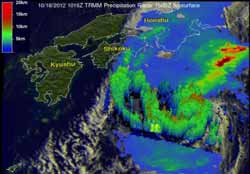NASA's TRMM satellite sees very heavy rains in fading Tropical Storm Prapiroon

Prapiroon's winds had dropped to less than 35 knots (~40 mph) when the TRMM data were collected on Oct. 18. Despite the drop in wind speed, some powerful thunderstorms around Prapiroon's center were still reaching heights above 12 kilometers (~7.6 miles).<br><br>Credit: SSAI/NASA, Hal Pierce<br>
NASA's Tropical Rainfall Measuring Mission (TRMM) satellite captured rainfall data on Prapiroon twice on Oct. 18 when it passed overhead. The first orbit was at 0845UTC and the second at 1019 UTC. TRMM's Microwave Imager (TMI) and Precipitation Radar (PR) data show that rain associated with Prapiroon was falling at a rate of over 75mm/hour (~3 inches) in a feeder band northwest of the center of circulation.
Some of the rainfall occurring over Japan on Oct. 18 was being caused by a frontal system that was interacting with tropical Storm Prapiroon.
At NASA's Goddard Space Flight Center in Greenbelt, Md., Hal Pierce of the TRMM team created a 3-D image of the storm using TRMM PR data received with the 1019 UTC (6:19 a.m. EDT) orbit. Prapiroon was once a powerful typhoon with winds of 100 knots (~115 mph). Prapiroon's winds had dropped to less than 35 knots (~40 mph/65 kph) when the TRMM data were collected. Despite the drop in wind speed, some powerful thunderstorms around Prapiroon's center were still reaching heights above 12 kilometers (~7.6 miles).
By 1500 UTC on Oct. 18, Prapiroon's maximum sustained winds dropped near 35 knots (40 mph/65 kph). Tropical storm Prapiroon was, located approximately 325 nautical miles south-southwest of yokosuka, japan, near 30.9 North latitude and 138.9 East longitude. The storm has accelerated northeastward at 33 knots (38 mph/62 kph) .
Just five hours after the second TRMM satellite overpass, the Joint Typhoon Warning Center noted that “animated infrared satellite imagery showed deep central convection has unraveled and sheared north of the low level circulation center.”
Prapiroon is undergoing transitioning while battling strong wind shear and is expected to become extra-tropical by Oct. 19.
Media Contact
More Information:
http://www.nasa.govAll latest news from the category: Earth Sciences
Earth Sciences (also referred to as Geosciences), which deals with basic issues surrounding our planet, plays a vital role in the area of energy and raw materials supply.
Earth Sciences comprises subjects such as geology, geography, geological informatics, paleontology, mineralogy, petrography, crystallography, geophysics, geodesy, glaciology, cartography, photogrammetry, meteorology and seismology, early-warning systems, earthquake research and polar research.
Newest articles

Superradiant atoms could push the boundaries of how precisely time can be measured
Superradiant atoms can help us measure time more precisely than ever. In a new study, researchers from the University of Copenhagen present a new method for measuring the time interval,…

Ion thermoelectric conversion devices for near room temperature
The electrode sheet of the thermoelectric device consists of ionic hydrogel, which is sandwiched between the electrodes to form, and the Prussian blue on the electrode undergoes a redox reaction…

Zap Energy achieves 37-million-degree temperatures in a compact device
New publication reports record electron temperatures for a small-scale, sheared-flow-stabilized Z-pinch fusion device. In the nine decades since humans first produced fusion reactions, only a few fusion technologies have demonstrated…





















